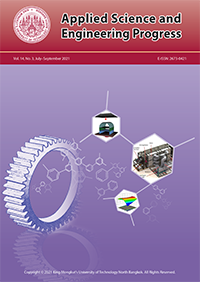Influence of Nitrate-nitrite Contamination on Pink Color Defect in Ginger Marinated Steamed Chicken Drumsticks
Main Article Content
Abstract
This study aimed at investigating influence of nitrate-nitrite contamination in ginger on pink color defect in marinated steamed chicken drumsticks. Three marinade formulations representing different degrees of nitratenitrite contamination were explored (i.e. no ginger (0 ppm) – A, ginger paste #1 containing 30 ppm nitrate – B, and ginger paste #2 containing 30 ppm nitrate + 8 ppm nitrite – C, respectively). Total myoglobin content was measured in chicken drumsticks before marination. Nitric oxide myoglobin (NOMb) was determined in the samples both before and after marination. After cooking, occurrences of pinking, a* value and nitrosyl hemochrome (NHC) content were evaluated. It was found that pink color defect was observed in treatment C. These results indicated that the presence of nitrite in ginger (treatment C) played a significant role in pinking appearance of steamed chicken drumstick. The maximum nitrite contamination in chicken drumstick was also investigated using sodium nitrite solution and it was found that it should not be more than 0.8 ppm. Thus, it is crucial to control the amount of nitrite contamination in ginger paste to avoid pink color defect formation.
Article Details
References
[2] K. Holownia, M. S. Chinnan, A. E. Reynolds, and P. E. Koehler, “Evaluation of induced color changes in chicken breast meat during simulation of pink color defect,” Poultry Science, vol. 82, no. 6, pp. 1049–1059, Jun. 2003.
[3] P. Ngamchuachit, Y. Kitai, S. Keeratipibul, and P. Phuwapraisirisan, “Comparison of dynamic headspace trapping on Tenax TA and headspace stir bar sorptive extraction for analysis of grilled chicken (yakitori) volatiles,” Applied Science and Engineering Progress, vol. 13, no. 3, pp. 202–212, 2020.
[4] G. W. Froning and T. E. Hartung, “Effect of age, sex, and strain on color and texture of turkey meat,” Poultry Science, vol. 46, no. 5, p. 1261, 1967.
[5] G. W. Froning, J. Daddario, T. E. Hartung, T. W. Sullivan, and R. M. Hill, “Color of poultry meat as influenced by dietary nitrates and nitrites, Poultry Science, vol. 48, no. 2, pp. 668–674, Mar. 1969.
[6] G. W. Froning, A. S. Babji, and F. B. Mather, “The effect of preslaughter temperature, stress, struggle and anesthetization on color and textural characteristics of turkey muscle,” Poultry Science, vol. 57, no. 3, pp. 630–633, May 1987.
[7] J. M. Walker, R. J. Buhr, and D. L. Fletcher, “Investigation of processing factors contributing to hemorrhagic leg syndrome in broilers,” Poultry Science, vol. 72, no. 8, pp. 1592–1596, Aug. 1993.
[8] D. M. Nash, F. G. Proudfoot, and H. W. Hulan, “Pink discoloration in cooked broiler chicken,” Poultry Science, vol. 64, no. 5, pp. 917–919, May 1985.
[9] J. L. Heath and S. L. Owens, “Effect of heating variables and storage on color of chicken cooked and stored in polyester pouches,” Poultry Science, vol. 71, no. 10, pp. 1773–1780, Oct. 1992.
[10] K. E. Friesen and J. A. Marcy, “Pinking in poultry symposium,” presented at the 53rd Annual Reciprocal Meat Conference Columbus, OH, USA, Jun. 18–21, 2000.
[11] K. M. Heaton, D. P. Cornforth, I. V. Moiseev, R. W. Egbert, and C. E. Carpenter, “Minimum sodium nitrite levels for pinking of various cooked meats as related to use of direct or indirect-dried soy isolates in poultry rolls,” Meat Science, vol. 55, no. 3, pp. 321–329, Jul. 2000.
[12] M. Wright and K. Davison, “ Nitrate accumulation in crops and nitrate poisoning in animals,” Advances in Agronomy, vol. 16, pp. 197–247, 1964.
[13] Y. Q. Cui, X. Li, L.Y Xu, M. X. Pang, J. H. Qi, and F. Wang, “Nitrite contents in fresh vegetables of different families and genus,” in IOP Conference Series: Materials Science and Engineering, 2017, vol. 275, pp. 1–7.
[14] P. D. Warriss, “The extraction of haem pigments from fresh meat,” Journal of Food Science and Technology, vol. 4, pp. 75–80, 1979.
[15] H. C. Hornsey, “The color of cooked cured pork. I.–Estimation of the nitric oxide-haem pigments,” Journal of the Science of Food and Agriculture, vol. 7 no. 8, pp. 534–540, Aug. 1956.
[16] D. A. Cataldo, M. Haroon, L. E. Schrader, and V. L. Youngs, “Rapid colorimetric determination of nitrate in plant-tissue by nitration of salicylicacid,” Communications in Soil Science and Plant Analysis, vol. 6, no. 1 pp. 71–80, 1975.
[17] C. S. James, Analytical Chemistry of Foods. London: Chapman & Hall, 1995, pp. 155–158.
[18] R. G. Cassens, “Residual nitrite in cured meat,” Food Technology, vol. 51, no. 2, pp. 53–55, 1997.


